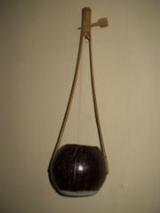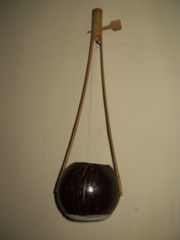
Ektara
Encyclopedia
Ektara is a one-string instrument used in Bangladesh
, India
, Egypt
, and Pakistan
.
 In origin the ektara was a regular string instrument
In origin the ektara was a regular string instrument
of wandering bards and minstrels from India and is plucked with one finger. The ektara usually has a stretched single string, an animal skin over a head (made of dried pumpkin/gourd, wood or coconut) and pole neck or split bamboo cane neck.
Pressing the two halves of the neck together loosens the string, thus lowering its pitch. The modulation of the tone with each slight flexing of the neck gives the ektara its distinctive sound. There are no markings or measurements to indicate what pressure will produce what note, so the pressure is adjusted by ear.
The various sizes of ektara are soprano, tenor, and bass. The bass ektara, sometimes called a dotara
often has two strings (as literally implied by do, "two").
chanting, which is a Hindu devotional practice of singing the divine names and mantras in an ecstatic call and response
format. Used by Sadhus, or wandering holy men. Also, the ektara is used for Sufi chanting as well as by the Baul
s of Bengal
.
The "dotara
" has been made popular in the United States by devotional Kirtan wallahs, such as the Western sadhu
Bhagavan Das, kirtan
recording artist, and author of Its Here Now, Are You?.
Ektara is the most ancient form of stringed instrument found in the Eastern parts of India, the instrument family being scattered all over the country. Though it has a humble tribal beginnings, it has been associated with and popularized by the ascetic and minstrel tradition of songs in Bengal.
The playing style of this instrument is a simultaneous pluck and gong, matching the rhythm of the music. The Ektara and the Ghati Baya, together form a complete set accompaniments, especially to Devotional and Deolati musical traditions. The string, as in a Dotara
, is tuned to the main/root note of the composition.
and Sindh
. Traditional and modern forms of bhangra sometimes use an ektara or tumbi
to accompany the singer and dhol
. On the occasion of "Urs" held in memory of the renowned saint and mystic poet Hazrat Shah Abdul Latif Bhitai (1689 - 1752) at Bhitshah, near Hyderabad in Sindh, held every year between 13th and 15th of Safar, devotees sing with fervor and frenzy his love-intoxicated Kafis to the strains of ektara which appears to be a very ancient musical instrument. Mention may also be made here of the Dotar of Khorasan. Nur-Mohammad Dorpur is a fampous traditional Dotar player from the Khorasan region. The renowned Kamancheh player Kayhan Kalhor who has performed at the famous 'Hollywood Bowl' in Los Angeles, also stresses the commonalities between the Indian and Persian musical traditions which are brought to a focus by instruments such as the Ektara and the Dotar.
Bangladesh
Bangladesh , officially the People's Republic of Bangladesh is a sovereign state located in South Asia. It is bordered by India on all sides except for a small border with Burma to the far southeast and by the Bay of Bengal to the south...
, India
India
India , officially the Republic of India , is a country in South Asia. It is the seventh-largest country by geographical area, the second-most populous country with over 1.2 billion people, and the most populous democracy in the world...
, Egypt
Egypt
Egypt , officially the Arab Republic of Egypt, Arabic: , is a country mainly in North Africa, with the Sinai Peninsula forming a land bridge in Southwest Asia. Egypt is thus a transcontinental country, and a major power in Africa, the Mediterranean Basin, the Middle East and the Muslim world...
, and Pakistan
Pakistan
Pakistan , officially the Islamic Republic of Pakistan is a sovereign state in South Asia. It has a coastline along the Arabian Sea and the Gulf of Oman in the south and is bordered by Afghanistan and Iran in the west, India in the east and China in the far northeast. In the north, Tajikistan...
.

String instrument
A string instrument is a musical instrument that produces sound by means of vibrating strings. In the Hornbostel-Sachs scheme of musical instrument classification, used in organology, they are called chordophones...
of wandering bards and minstrels from India and is plucked with one finger. The ektara usually has a stretched single string, an animal skin over a head (made of dried pumpkin/gourd, wood or coconut) and pole neck or split bamboo cane neck.
Pressing the two halves of the neck together loosens the string, thus lowering its pitch. The modulation of the tone with each slight flexing of the neck gives the ektara its distinctive sound. There are no markings or measurements to indicate what pressure will produce what note, so the pressure is adjusted by ear.
The various sizes of ektara are soprano, tenor, and bass. The bass ektara, sometimes called a dotara
Dotara
The dotara is a two or four or some times five stringed musical instrument resembling more to mandolin than a guitar...
often has two strings (as literally implied by do, "two").
Ektar and Kirtan
These instruments are commonly used in KirtanKirtan
Kirtan or Kirtana is call-and-response chanting or "responsory" performed in India's devotional traditions. A person performing kirtan is known as a kirtankar. Kirtan practice involves chanting hymns or mantras to the accompaniment of instruments such as the harmonium, tablas, the two-headed...
chanting, which is a Hindu devotional practice of singing the divine names and mantras in an ecstatic call and response
Call and response
Call and response is a form of "spontaneous verbal and non-verbal interaction between speaker and listener in which all of the statements are punctuated by expressions from the listener."...
format. Used by Sadhus, or wandering holy men. Also, the ektara is used for Sufi chanting as well as by the Baul
Baul
Baul .Though Bauls comprise only a small fraction of the Bengali population, their influence on the culture of Bengal is considerable. In 2005, the Baul tradition was included in the list of "Masterpieces of the Oral and Intangible Heritage of Humanity" by UNESCO.-Etymology:The origin of the word...
s of Bengal
Bengal
Bengal is a historical and geographical region in the northeast region of the Indian Subcontinent at the apex of the Bay of Bengal. Today, it is mainly divided between the sovereign land of People's Republic of Bangladesh and the Indian state of West Bengal, although some regions of the previous...
.
The "dotara
Dotara
The dotara is a two or four or some times five stringed musical instrument resembling more to mandolin than a guitar...
" has been made popular in the United States by devotional Kirtan wallahs, such as the Western sadhu
Sadhu
In Hinduism, sādhu denotes an ascetic, wandering monk. Although the vast majority of sādhus are yogīs, not all yogīs are sādhus. The sādhu is solely dedicated to achieving mokṣa , the fourth and final aśrama , through meditation and contemplation of brahman...
Bhagavan Das, kirtan
Kirtan
Kirtan or Kirtana is call-and-response chanting or "responsory" performed in India's devotional traditions. A person performing kirtan is known as a kirtankar. Kirtan practice involves chanting hymns or mantras to the accompaniment of instruments such as the harmonium, tablas, the two-headed...
recording artist, and author of Its Here Now, Are You?.
Ektara is the most ancient form of stringed instrument found in the Eastern parts of India, the instrument family being scattered all over the country. Though it has a humble tribal beginnings, it has been associated with and popularized by the ascetic and minstrel tradition of songs in Bengal.
Bengali Ektara
A typical Bengali Ektara is constructed out of a half of a dried gourd shell serving as the sound-box, with a metal string running right through the middle of the shell; at the top, the string is tied to a knob, which adjusts the tension the of the string and thereby, the tuning—the knob and the string-tension is supported by two bamboo-strips, tied to two opposite sides of the gourd shell.The playing style of this instrument is a simultaneous pluck and gong, matching the rhythm of the music. The Ektara and the Ghati Baya, together form a complete set accompaniments, especially to Devotional and Deolati musical traditions. The string, as in a Dotara
Dotara
The dotara is a two or four or some times five stringed musical instrument resembling more to mandolin than a guitar...
, is tuned to the main/root note of the composition.
Ektara in Sindhi and Punjabi folk music
Nowadays the ektara is widely used by folk singers especially by Sufi singers in PunjabPunjab (Pakistan)
Punjab is the most populous province of Pakistan, with approximately 45% of the country's total population. Forming most of the Punjab region, the province is bordered by Kashmir to the north-east, the Indian states of Punjab and Rajasthan to the east, the Pakistani province of Sindh to the...
and Sindh
Sindh
Sindh historically referred to as Ba'ab-ul-Islam , is one of the four provinces of Pakistan and historically is home to the Sindhi people. It is also locally known as the "Mehran". Though Muslims form the largest religious group in Sindh, a good number of Christians, Zoroastrians and Hindus can...
. Traditional and modern forms of bhangra sometimes use an ektara or tumbi
Tumbi
The Tumbi or Toombi is a traditional North Indian instrument from Punjab. The tumbi was invented and popularized by the renowned folk-singer of Punjab "Lal Chand Yamla Jatt". In the 1960s, 70s and 80s most of the Punjabi singers used the Tumbi...
to accompany the singer and dhol
Dhol
Dhol can refer to any one of a number of similar types of double-headed drum widely used, with regional variations, throughout the Indian subcontinent and nearby regions. Its range of distribution in India and Pakistan primarily includes northern areas such as the Assam Valley, Bengal, Gujarat,...
. On the occasion of "Urs" held in memory of the renowned saint and mystic poet Hazrat Shah Abdul Latif Bhitai (1689 - 1752) at Bhitshah, near Hyderabad in Sindh, held every year between 13th and 15th of Safar, devotees sing with fervor and frenzy his love-intoxicated Kafis to the strains of ektara which appears to be a very ancient musical instrument. Mention may also be made here of the Dotar of Khorasan. Nur-Mohammad Dorpur is a fampous traditional Dotar player from the Khorasan region. The renowned Kamancheh player Kayhan Kalhor who has performed at the famous 'Hollywood Bowl' in Los Angeles, also stresses the commonalities between the Indian and Persian musical traditions which are brought to a focus by instruments such as the Ektara and the Dotar.

